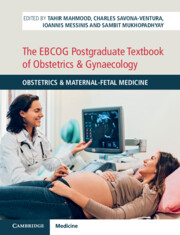Book contents
- The EBCOG Postgraduate Textbook of Obstetrics & Gynaecology
- The EBCOG Postgraduate Textbook of Obstetrics & Gynaecology
- Copyright page
- Dedication
- Contents
- Contributors
- Preface
- Section 1 Basic Sciences in Obstetrics
- Section 2 Early Pregnancy Problems
- Section 3 Fetal Medicine
- Section 4 Maternal Medicine
- Chapter 25 Hypertensive Disorders in Pregnancy and Eclampsia
- Chapter 26 Obesity and Metabolic Syndrome in Pregnancy
- Chapter 27 Screening for Gestational Diabetes Mellitus and Care of Diabetes Mellitus in Pregnancy
- Chapter 28 Cardiac Disease in Pregnancy
- Chapter 29 Respiratory Disease in Pregnancy
- Chapter 30 Thromboembolism in Pregnancy
- Chapter 31 Haemoglobinopathies in Pregnancy
- Chapter 32 Kidney Diseases in Pregnancy
- Chapter 33 Gastrointestinal Disorders in Pregnancy
- Chapter 34 Systemic Lupus Erythematosus and Pregnancy
- Chapter 35 Autoimmune Rheumatic Disorders in Pregnancy
- Chapter 36 Thyroid Disease in Pregnancy
- Chapter 37 Infections in Pregnancy
- Chapter 38 HIV Infection in Pregnancy
- Chapter 39 Acute Management of Sepsis in Pregnancy
- Chapter 40 Psychological Disorders in Pregnancy
- Chapter 41 Pregnancy after Solid Organ Transplantation
- Chapter 42 Oral Health and Periodontal Diseases in Pregnancy
- Section 5 Intrapartum Care
- Section 6 Neonatal Problems
- Section 7 Placenta
- Section 8 Public Health Issues in Obstetrics
- Section 9 Co-Morbidities during Pregnancy
- Index
- Plate Section (PDF Only)
- References
Chapter 40 - Psychological Disorders in Pregnancy
from Section 4 - Maternal Medicine
Published online by Cambridge University Press: 20 November 2021
- The EBCOG Postgraduate Textbook of Obstetrics & Gynaecology
- The EBCOG Postgraduate Textbook of Obstetrics & Gynaecology
- Copyright page
- Dedication
- Contents
- Contributors
- Preface
- Section 1 Basic Sciences in Obstetrics
- Section 2 Early Pregnancy Problems
- Section 3 Fetal Medicine
- Section 4 Maternal Medicine
- Chapter 25 Hypertensive Disorders in Pregnancy and Eclampsia
- Chapter 26 Obesity and Metabolic Syndrome in Pregnancy
- Chapter 27 Screening for Gestational Diabetes Mellitus and Care of Diabetes Mellitus in Pregnancy
- Chapter 28 Cardiac Disease in Pregnancy
- Chapter 29 Respiratory Disease in Pregnancy
- Chapter 30 Thromboembolism in Pregnancy
- Chapter 31 Haemoglobinopathies in Pregnancy
- Chapter 32 Kidney Diseases in Pregnancy
- Chapter 33 Gastrointestinal Disorders in Pregnancy
- Chapter 34 Systemic Lupus Erythematosus and Pregnancy
- Chapter 35 Autoimmune Rheumatic Disorders in Pregnancy
- Chapter 36 Thyroid Disease in Pregnancy
- Chapter 37 Infections in Pregnancy
- Chapter 38 HIV Infection in Pregnancy
- Chapter 39 Acute Management of Sepsis in Pregnancy
- Chapter 40 Psychological Disorders in Pregnancy
- Chapter 41 Pregnancy after Solid Organ Transplantation
- Chapter 42 Oral Health and Periodontal Diseases in Pregnancy
- Section 5 Intrapartum Care
- Section 6 Neonatal Problems
- Section 7 Placenta
- Section 8 Public Health Issues in Obstetrics
- Section 9 Co-Morbidities during Pregnancy
- Index
- Plate Section (PDF Only)
- References
Summary
Psychological disorders always have an impact not only on the individual, but also on all family members, especially partners and children. In the case of a pregnancy, the situation becomes even more complex, as the psychological problem and its treatment might in addition have an impact on the unborn child. Furthermore, psychological problems may compromise fertility and the course of pregnancy, as well as the peri- and postnatal period, and they might be aggravated due to pregnancy and the challenges of motherhood. Pregnancy implies emotional, physical and social changes for the mother, her partner and the rest of the family, but while many mothers greatly enjoy these changes and adapt well to them, others – and especially women at risk for or with pre-existing psychological disorders –may react with severe distress. Women´s socio-economic and cultural context features are modulators of the adaptive responses to the pregnancy, and unfavourable economic conditions or specific social circumstances make it harder to cope. In order to prevent negative long-term effects on the newborn, the mother and the entire family, early detection and adequate care of all pregnant women at risk for psychological maladjustment is of utmost importance and has an impact on mental health and well-being. This chapter describes psychological disorders pregnant women may suffer from, discusses diagnostic procedures as well as treatment options and explains preventive strategies.
- Type
- Chapter
- Information
- The EBCOG Postgraduate Textbook of Obstetrics & GynaecologyObstetrics & Maternal-Fetal Medicine, pp. 337 - 342Publisher: Cambridge University PressPrint publication year: 2021

